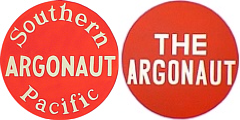
The Southern Pacific was an American Class I railroad network that existed from 1865 to 1996 and operated largely in the Western United States. The system was operated by various companies under the names Southern Pacific Railroad, Southern Pacific Company and Southern Pacific Transportation Company.
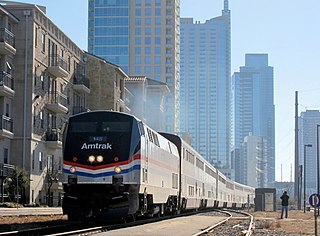
The Texas Eagle is a long-distance passenger train operated daily by Amtrak on a 1,306-mile (2,102 km) route between Chicago, Illinois, and San Antonio, Texas, with major stops in St. Louis, Little Rock, Dallas, Fort Worth, and Austin. Three days per week, the train joins the Sunset Limited in San Antonio and continues to Los Angeles via El Paso and Tucson. The combined 2,728-mile (4,390 km) route is the longest in the United States and the second-longest in the Americas, after the Canadian.

The Atchison, Topeka and Santa Fe Railway, often referred to as the Santa Fe or AT&SF, was one of the largest Class 1 railroads in the United States between 1859 and 1996.

The Coast Starlight is a long-distance passenger train operated by Amtrak on the West Coast of the United States between Seattle and Los Angeles via Portland and the San Francisco Bay Area. The train, which has operated continuously since Amtrak's formation in 1971, was the first to offer direct service between Seattle and Los Angeles. Its name is a combination of two prior Southern Pacific (SP) trains, the Coast Daylight and the Starlight.

The Sunset Limited is a long-distance passenger train run by Amtrak, operating on a 1,995-mile (3,211 km) route between New Orleans and Los Angeles. Major stops include Houston, San Antonio and El Paso in Texas, as well as Tucson, Arizona. Opening in 1894 through the Southern Pacific Railroad, Sunset Limited is the oldest continuously operating named train in the United States.
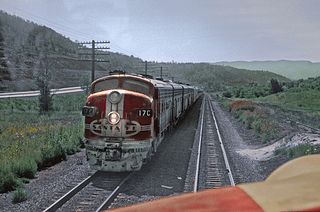
The Chief was an American long-distance named passenger train of the Atchison, Topeka and Santa Fe Railway that ran between Chicago, Illinois and Los Angeles, California. The Santa Fe initiated the Chief in 1926 to supplement the California Limited. In 1936 the Super Chief was introduced, after the Super Chief was relaunched in 1948 with daily departures from LA and Chicago it gradually eclipsed the Chief as the standard bearer of the Santa Fe because of its timetable oriented to the Raton Pass transit. For some the Chief and San Francisco Chief as deluxe integrated trains with both Pullman sleepers and fully reclining coach seating with all facilities; lounges and pleasure domes, available to all passengers were at least equal flagships better suited to the business and executive market. From the mid 1960s the super Chief was only a small entirely separate section of the El Capitan seated vista train, the El Capitan passengers having no access to the Super Chiefs expensive eateries and bars which selling point was exclusion and service. The Chief was discontinued in 1968 due to high operating costs, competition from airlines, and the loss of Postal Office contracts.

The Coast Daylight, originally known as the Daylight Limited, was a passenger train on the Southern Pacific Railroad (SP) between Los Angeles and San Francisco, California, via SP's Coast Line. It was advertised as the "most beautiful passenger train in the world," carrying a particular red, orange, and black color scheme. The train operated from 1937 until 1974, being retained by Amtrak in 1971. Amtrak merged it with the Coast Starlight in 1974.

The Texas and Pacific Railway Company was created by federal charter in 1871 with the purpose of building a southern transcontinental railroad between Marshall, Texas, and San Diego, California.

The Golden State was a named passenger train between Chicago and Los Angeles from 1902–1968 on the Chicago, Rock Island and Pacific Railroad and the Southern Pacific Company (SP) and predecessors. It was named for California, the “Golden State”.

Phoenix Union Station is a former train station at 401 South 4th Avenue in downtown Phoenix, Arizona, United States. From 1971 to 1996 it was an Amtrak station. Until 1971, it was a railroad stop for the Santa Fe and Southern Pacific Railroads. Union Station was served by Amtrak's Los Angeles–New Orleans Sunset Limited and Los Angeles–Chicago Texas Eagle. The station is on the National Register of Historic Places.

Tucson station is an Amtrak train depot in Tucson, Arizona, served three times a week by the combined Sunset Limited/Texas Eagle train.

The Texas and New Orleans Railroad (TNO) was an American rail company in Texas and Louisiana. It operated 3,713 miles (5,975 km) of railroad in 1934; by 1961, 3,385 miles (5,448 km) remained when it merged with parent company Southern Pacific.

The Lark was an overnight passenger train of the Southern Pacific Company on the 470-mile (760 km) run between San Francisco and Los Angeles. It became a streamliner in 1941 and was discontinued on April 8, 1968. The Lark ran along the same route as the Coast Daylight and was often pulled by a locomotive wearing the famous Daylight paint scheme of orange, red, and black.

The Texas Chief was a passenger train operated by the Atchison, Topeka & Santa Fe Railway between Chicago, Illinois and Galveston, Texas. It was the first Santa Fe "Chief" outside the Chicago–Los Angeles routes. The Santa Fe conveyed the Texas Chief to Amtrak in 1971, which renamed it the Lone Star in 1974. The train was discontinued in 1979.

The Cascade was a passenger train of the Southern Pacific on its route between Oakland, California, and Portland, Oregon, with a sleeping car to Seattle, Washington. The Southern Pacific started the train on April 17, 1927, soon after the opening of its Cascade Line between Black Butte, California, and Springfield, Oregon.

Southern Pacific Railroad 2467 is a preserved 4-6-2 “Pacific” type steam locomotive. Built by Baldwin in 1921, it was used by the Southern Pacific Railroad to pull passenger trains until it was retired from service in 1956. On July 25, 1960, it was donated to the city of Oakland, California, who had it placed on display at the Harrison Railroad Park. In July 1990 a restoration began by the Friends of the 2467, which later merged into the Pacific Locomotive Association. In June 1999 it was returned to operation and made an appearance at Railfair 1999. Although serviceable, SP 2467 is currently on static display while on loan from its operator, Pacific Locomotive Association, Inc., to the California State Railroad Museum in Sacramento, California.
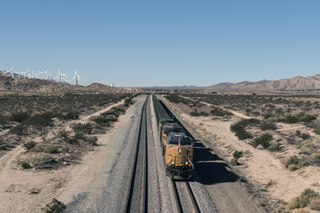
The Sunset Route is a main line of the Union Pacific Railroad running between Southern California and New Orleans, Louisiana.
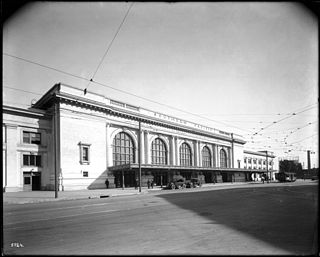
Central Station was the Southern Pacific Railroad's main passenger terminal in Los Angeles, California. It was formerly on Central Avenue at Fifth Street, in eastern Downtown Los Angeles. The primary hub for Southern Pacific's passenger operations in Southern California, it was served by the Sunset Limited, Coast Daylight, Golden State, and other named trains. The station replaced the company's previous Los Angeles terminal, Arcade Depot, and was often referred to by the name of the older facility.
The history of the Southern Pacific ("SP") stretched from 1865 to 1998.
Barstow Yard is a classification yard operated by Burlington Northern Santa Fe Railway (BNSF) in Barstow, California. With 48 directional tracks and a total area of approximately 600 acres (240 ha), it is the second largest classification yard west of the Rocky Mountains after the JR Davis Yard. Today, almost all freight traffic to and from Southern California runs through the junction.
